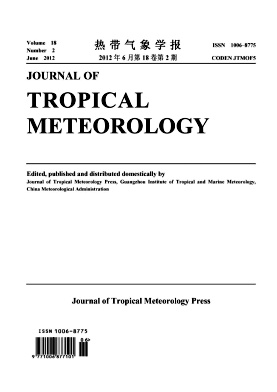|
[1]
|
CHEN Lian-shou, DING Yi-hui. Introduction to the Western Pacific typhoons (in Chinese) [M]. Beijing: Science Press, 1979: 491pp. |
|
[2]
|
POWELL M D. The transition of the hurricane Frederic boundary-layer wind field from the open Gulf of Mexico to landfall [J]. Mon. Wea. Rev., 1982, 110(12): 1912-1932. |
|
[3]
|
POWELL M D. Changes in the low-level kinematic and thermodynamic structure of hurricane Alicia (1983) at landfall[J]. Mon. Wea. Rev., 1987, 115(1): 75-79. |
|
[4]
|
POWELL M D, HOUSTON S H. Surface wind fields of 1995 hurricanes Erin, Opal, Luis, Marilyn, and Roxanne at landfall [J]. Mon. Wea. Rev., 1998, 126(5): 1259-1273. |
|
[5]
|
TULEYA R E. Tropical storm development and decay: Sensitivity to surface boundary conditions [J]. Mon. Wea. Rev., 1994, 122(2): 291-304. |
|
[6]
|
TULEYA R E, BENDER M A, KURIHARA Y. A simulation study of the landfall of tropical cyclones using a movable nested-mesh model [J]. Mon.Wea. Rev., 1984, 112(1): 124-136. |
|
[7]
|
SHEN W, GINIS I, TULEYA R E. A numerical investigation of land surface water on landfalling hurricanes [J]. J. Atmos. Sci., 2002, 59(4): 789-802. |
|
[8]
|
CHEN Lian-shou. Decay after landfall [M]. WMO/TD, 1998: 875, 1.1.6-1.1.7. |
|
[9]
|
DING Yi-hui, LIU Yi-zong. Study on the moisture budget in typhoon (7507) [J]. Acta Oceanol. Sinica, 1986, 8(3): 291-301. |
|
[10]
|
TAN Ran-zi, LIANG Bo-qi, Comparative study on the decaying and the extratropical transition of making landfall typhoon [J]. J. Sun Yat-sen Univ. (Nat. Sci.), 1989, 28(4): 15-21. |
|
[11]
|
EMANUEL K A. The maximum intensity of hurricane [J]. J. Atmos. Sci., 1988, 45(7): 1143-1155. |
|
[12]
|
HOLLAND G J. The maximum potential intensity of tropical cyclone [J]. J. Atmos. Sci., 1997, 54(21): 2519-2541. |
|
[13]
|
WANG Y Q, WANG Y, FUDEYASU H. The role of Typhoon Songda (2004) in producing distantly located heavy rainfall in Japan [J]. Mon. Wea. Rev., 2009, 137(11): 3699-3716. |
|
[14]
|
HOLLAND G J, MERRILL R T. On the dynamics of tropical cyclone structural changes [J]. Quart. J. Roy. Meteor. Soc. 1984, 110(465): 723-745. |
|
[15]
|
MOLINARI J, VOLLARO D. External influences on hurricane intensity. Part I: Outflow layer eddy angular momentum fluxes [J]. J. Atmos. Sci., 1989, 46(8): 1093-1105. |
|
[16]
|
Molinari J, VOLLARO D. External influences on hurricane intensity. Part II: Vertical structure and response of hurricane vortex [J]. J. Atmos. Sci., 1990, 47(15): 1902-1918. |
|
[17]
|
PERSING J, MONTGOMERY M T, TULEYA R E. Environmental interactions in the GFDL hurricane model for Hurricane Opal [J]. Mon. Wea. Rev., 2002, 130(2): 298-317. |
|
[18]
|
HANLEY D E, MOLINARI J, KEYSER D. A composite study of the interaction between tropical cyclones and upper tropospheric troughs [J]. Mon. Wea. Rev., 2001, 129(10): 2570-2584. |
|
[19]
|
GUO Li-xian, CHEN Lian-shou, LI Ying, et al. Statistical characteristics of intensity change of tropical cyclones landing in China before moving out to sea [J]. J. Trop. Meteor., 2010, 26(1): 65-70. |
|
[20]
|
SKAMAROCK W C, KLEMP J B. A time split non hydrostatic atmospheric model for weather research and forecasting applications [J]. J. Comp. Physics., 2008, 227(7): 3465-3485. |
|
[21]
|
FERRIER B S. A double-moment multiple-phase four-class bulk ice scheme. Part I: Description [J]. J. Atmos. Sci., 1994, 51(2): 249-280. |
|
[22]
|
MLAWER E J, TAUBMAN S J, BROWN P D, et al. Radiative transfer for inhomogeneous atmosphere: RRTM, a validated correlated-k model for the long-wave [J]. J. Geophys. Res., 1997, 102 (D14), 16663-16682. |
|
[23]
|
CHOU M D, SUAREZ M J. An efficient thermal infrared radiation parameterization for use in general circulation models (Vol. 3) [M]. NASA Tech. Memo. 104606, 1994: 85pp. |
|
[24]
|
SMIRNOVA T G, BROWN J M, BENJAMIN S G. Performance of different soil model configurations in simulating ground surface temperature and surface fluxes [J]. Mon. Wea. Rev., 1997, 125(8): 1870-1884. |
|
[25]
|
SMIRNOVA T G, BROWN J M, BENJAMIN S G, et al. Parameterization of cold-season processes in the MAPS land-surface scheme [J]. J. Geophys. Res., 2000, 105 (D3), 4077-4086. |
|
[26]
|
HONG S Y, NOH Y, DUDHIA J. A new vertical diffusion package with an explicit treatment of entrainment processes [J]. Mon. Wea. Rev., 2006, 134(9): 2318-2341. |
|
[27]
|
KAIN J S, FRITSCH J M. A one-dimensional entraining/detraining plume model and its application in convective parameterization [J]. J. Atmos. Sci., 1990, 47(23): 2784-2802. |
|
[28]
|
ROSS R J, KURIHARA Y. A numerical study on influences of Hurricane Gloria (1985) on the environment [J]. Mon. Wea. Rev., 1995, 123(2): 332-346. |
|
[29]
|
KURIHARA Y, BENDER M A, TULEYA R E, et al. Prediction experiments of Hurricane Gloria (1985) using a multiply nested movable mesh model [J]. Mon. Wea. Rev., 1990, 118(10): 2185-2198. |
|
[30]
|
ZENG Zi-hua, WANG Yan, DUAN Yi, et al. On sea surface roughness parameterization and its effect on tropical cyclone structure and intensity [J]. Adv. Atmos. Sci., 2010, 27(2): 337-355. |
|
[31]
|
BANACOS P C, SCHULTZ D M. The use of moisture flux convergence in forecasting convective initiation: Historical and operational perspectives [J]. Wea. Forecasting, 2005, 20(3), 351-366. |

















 粤公网安备 4401069904700002号
粤公网安备 4401069904700002号
 DownLoad:
DownLoad: